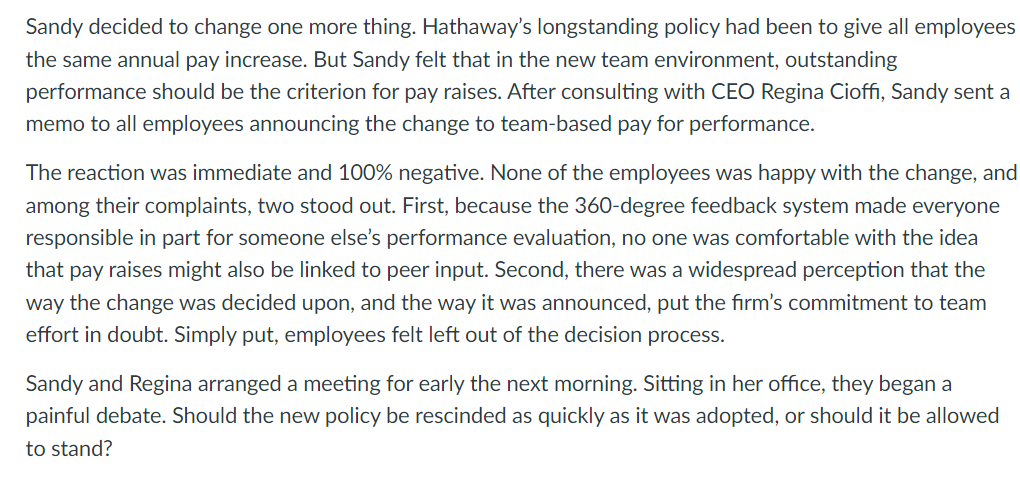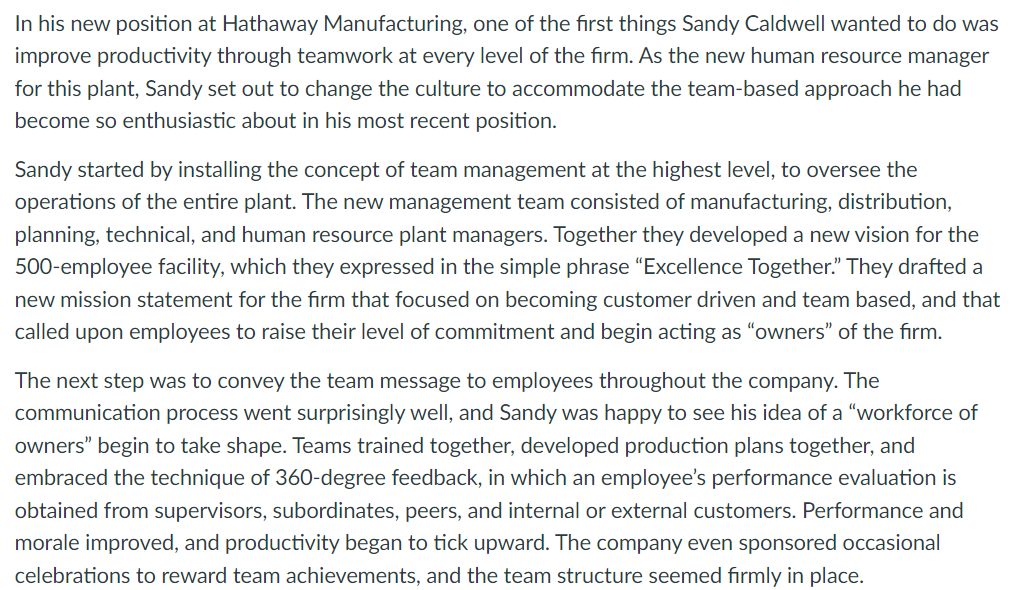Does the pay for performance plan seem like a good idea? Why or why not? What advice would you give Regina and Sandy as they consider their decision?
Does the pay for performance plan seem like a good idea? Why or why not? What advice would you give Regina and Sandy as they consider their decision?
Management, Loose-Leaf Version
13th Edition
ISBN:9781305969308
Author:Richard L. Daft
Publisher:Richard L. Daft
Chapter10: Designing Organization Structure
Section: Chapter Questions
Problem 1ED
Related questions
Question
Questions:
- Does the pay for performance plan seem like a good idea? Why or why not?
- What advice would you give Regina and Sandy as they consider their decision?

Transcribed Image Text:Sandy decided to change one more thing. Hathaway's longstanding policy had been to give all employees
the same annual pay increase. But Sandy felt that in the new team environment, outstanding
performance should be the criterion for pay raises. After consulting with CEO Regina Cioffi, Sandy sent a
memo to all employees announcing the change to team-based pay for performance.
The reaction was immediate and 100% negative. None of the employees was happy with the change, and
among their complaints, two stood out. First, because the 360-degree feedback system made everyone
responsible in part for someone else's performance evaluation, no one was comfortable with the idea
that pay raises might also be linked to peer input. Second, there was a widespread perception that the
way the change was decided upon, and the way it was announced, put the firm's commitment to team
effort in doubt. Simply put, employees felt left out of the decision process.
Sandy and Regina arranged a meeting for early the next morning. Sitting in her office, they began a
painful debate. Should the new policy be rescinded as quickly as it was adopted, or should it be allowed
to stand?

Transcribed Image Text:In his new position at Hathaway Manufacturing, one of the first things Sandy Caldwell wanted to do was
improve productivity through teamwork at every level of the firm. As the new human resource manager
for this plant, Sandy set out to change the culture to accommodate the team-based approach he had
become so enthusiastic about in his most recent position.
Sandy started by installing the concept of team management at the highest level, to oversee the
operations of the entire plant. The new management team consisted of manufacturing, distribution,
planning, technical, and human resource plant managers. Together they developed a new vision for the
500-employee facility, which they expressed in the simple phrase “Excellence Together." They drafted a
new mission statement for the firm that focused on becoming customer driven and team based, and that
called upon employees to raise their level of commitment and begin acting as "owners" of the firm.
The next step was to convey the team message to employees throughout the company. The
communication process went surprisingly well, and Sandy was happy to see his idea of a "workforce of
owners" begin to take shape. Teams trained together, developed production plans together, and
embraced the technique of 360-degree feedback, in which an employee's performance evaluation is
obtained from supervisors, subordinates, peers, and internal or external customers. Performance and
morale improved, and productivity began to tick upward. The company even sponsored occasional
celebrations to reward team achievements, and the team structure seemed fırmly in place.
Expert Solution
This question has been solved!
Explore an expertly crafted, step-by-step solution for a thorough understanding of key concepts.
This is a popular solution!
Trending now
This is a popular solution!
Step by step
Solved in 3 steps

Recommended textbooks for you

Management, Loose-Leaf Version
Management
ISBN:
9781305969308
Author:
Richard L. Daft
Publisher:
South-Western College Pub

Management, Loose-Leaf Version
Management
ISBN:
9781305969308
Author:
Richard L. Daft
Publisher:
South-Western College Pub